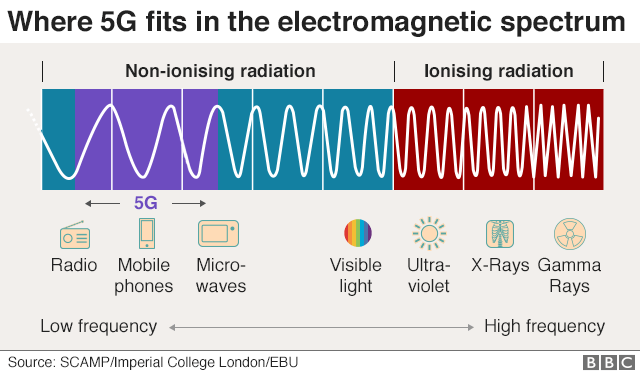UK's 5G network well within safety limits, Ofcom tests find
- Published
- comments

Protesters - like this man in Warsaw in April - have rallied against 5G
The first UK safety tests of 5G base stations has found radiation levels are at "tiny fractions" of safe limits.
The rollout of ultra-fast 5G mobile connectivity has sparked some fears the new transmission masts could be dangerous to humans.
But Ofcom, the UK regulator, found no identifiable risks in its first tests since 5G technology was deployed.
The highest result they found for the 5G band was 0.039% of the recommended exposure limit.
Those limits are set by the International Commission on Non-Ionizing Radiation Protection (ICNIRP) - non-ionizing meaning the type that does not damage DNA and cells.
"The emissions at each site were a tiny fraction of the maximum levels set out in international guidelines," an Ofcom spokesman said.
The tests covered 16 locations in 10 cities across the UK where 5G-enabled mobile base stations had been set up, and measured the strength of the electromagnetic field (EMF).


Put the term "5G" into Facebook's search box and you can rapidly disappear down a rabbit hole.
Take a group called Working Together to Keep Devon 5G Free - the first post is a YouTube video advancing the theory the coronavirus originated in Wuhan because the Chinese city had rolled out 5G. Another post talks of pressurising a school to shut down its wi-fi network - those campaigning against 5G have often expressed similar fears about previous technologies.
And the campaigns are having some effect - a number of local councils in the south-west of England have voted to "ban 5G", although it is not clear they have the power to stop the rollout. The councils and campaigners have been calling for evidence 5G is safe.
Now, Ofcom has provided some. But it seems unlikely the scare stories will just fade away.

The highest EMF emissions for 5G were recorded in Birmingham's Mailbox development, external. By contrast, the highest strength for all mobile bands was in London's Canary Wharf, at 1.5% the safe limit - but a zero 5G measurement.
Is there a health risk?
Ofcom has been measuring EMF emissions from mobile phone towers since 2003. But all four major UK networks have launched 5G in the past year, prompting Ofcom to test that band.
It said the rollout of 5G had seen a renewal of interest in the possible health effects of radio waves and it was receiving an "increasing number of queries" about 5G.
"Clearly, the deployment of 5G networks and the take-up of 5G services is at an early stage," it said in the technical report outlining its findings.
"We will therefore continue to undertake EMF measurements to monitor the overall trends in the long term."
Despite the public concern, health authorities have consistently declared 5G safe for use.

Public Health England acknowledges adding 5G to the existing technologies used could cause "a small increase in overall exposure to radio waves".
"However, the overall exposure is expected to remain low relative to guidelines and, as such, there should be no consequences for public health," it says in its official guidance, external.
The World Health Organization, meanwhile, classified radio frequency radiation as a "possible carcinogenic". That puts it in the same category as pickled vegetables or talcum powder but not as dangerous as alcohol or processed meat.
- Published15 July 2019

- Published30 May 2019
